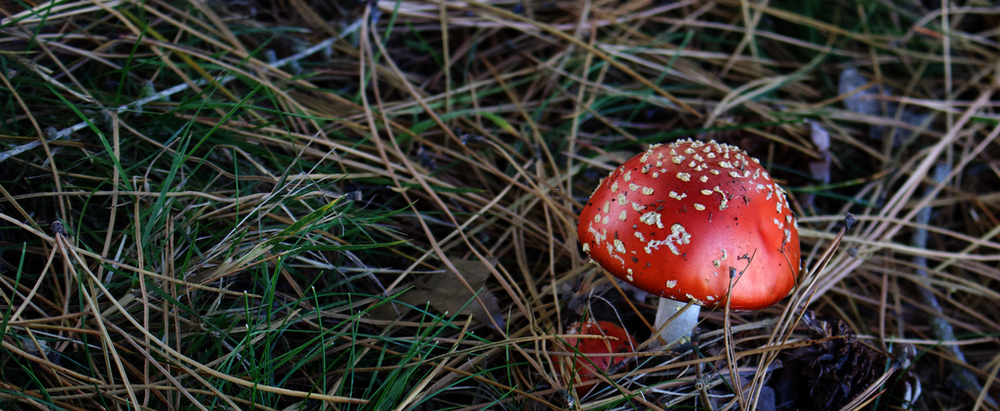
A Road Trip, A Fibre Festival, and A Raffle
Hello friends,
It's been a couple of weeks since my last blog post, but I've been busy, with a friend coming down from Wellington to visit us for a week. We got up to a lot of crafty things while she was here, and we spent many relaxing afternoons sitting on the couch watching disaster movies and knitting and spinning.
One of the highlights of the week was a road trip from Dunedin to Gore for the 45˚Fibre Festival in Gore on Saturday the 4th of May. We got up early on Saturday morning and headed off on our road trip down south.
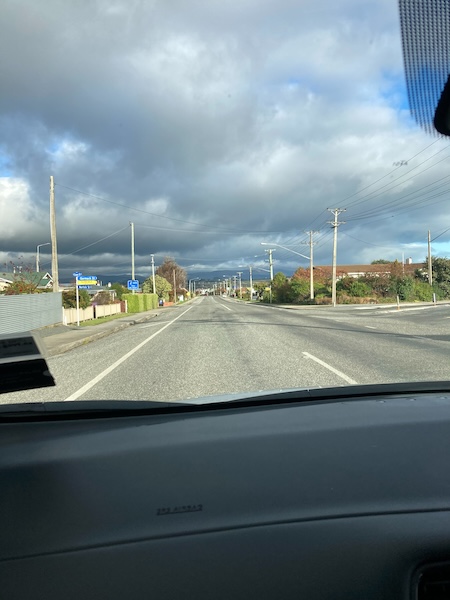
It was cool but dry morning, and two hours later we made it to Gore, and excitedly found our way to the Gore Town and Country Club for the Fiber Festival.
Outside the venue we were greeted with some great fiber based art installations.
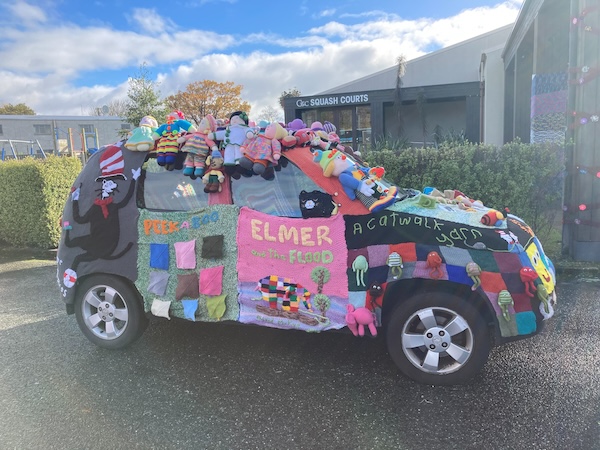
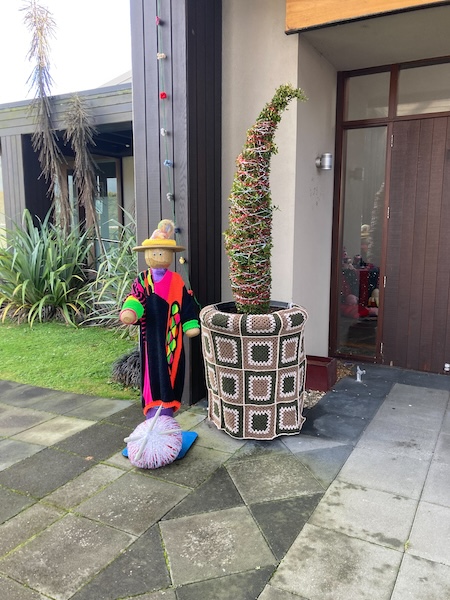
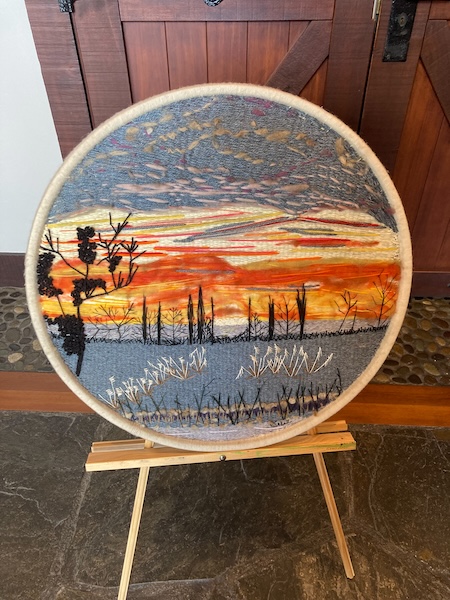
Once inside the fibre festival we were overwhelmed with a large number of yarn and fibre traders waiting for our patronage. There were local farmers selling raw and processed fleeces, indie dyers and yarn traders from all over the country, and other traders selling all sorts of yarn and fibre accessories.
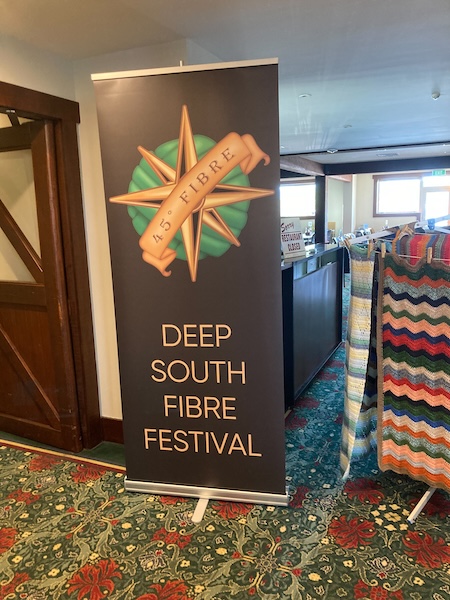
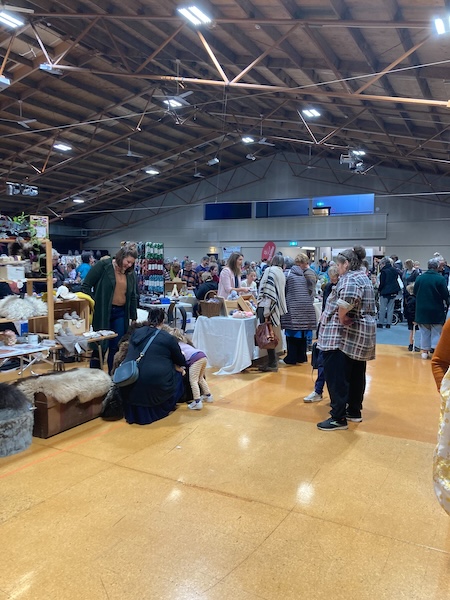
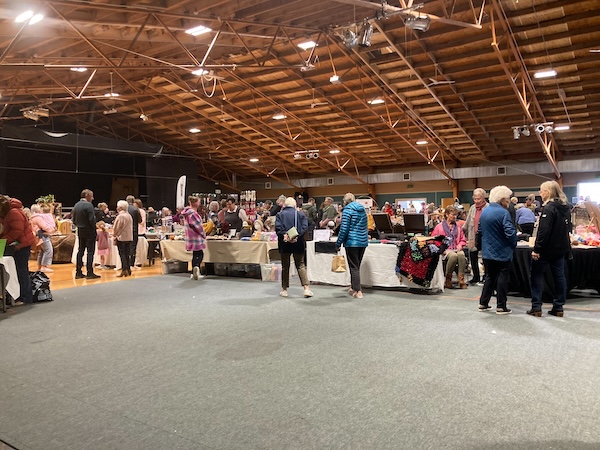
After wandering around and getting an idea of what was for sale, it was time to shop. I had saved up a lot of crafty pocket money for this event, and it was time to fulfill my wish list.
First up was purchasing some more Unicorn Power Scour from Unicorn Fibre Cleaners NZ. I'm currently in the middle of processing two raw fleece projects (blog posts to come), and I've found that Unicorn Power Scour is the most gentle, easy, and efficient fleece cleaner I've ever used. I'll never process fleeces any other way now.

Next on my shopping list, was a skein of 4 ply yarn for making a pair of socks. After wandering around for a while, I found the perfect colour at Dye Studio 54, who had 100 grams of Sparkle Sock in the colourway Belladonna. It was a perfect combination of purple and sparkles, and I can't wait to knit it up so I can have sparkly warm feet for winter.
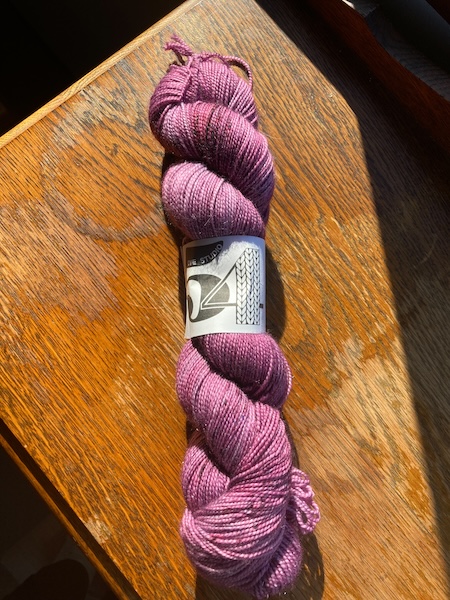
As a spinner I always like to pick up some dyed fibre to spin, and I found two preparations at the Handmade Fibre Crafts stall. I picked up 100 grams of dyed merino combed top with silk and viscose in shades of orange, white and pinks. I also grabbed 50 grams of dyed Corriedale combed top with mulberry silk in shades of orange. I figured the two preparations would work well together in a future project (unknown project at this time).

Next up it was time to check out two of my favorite fibre processors. I also love to dye my own fibre, so I headed first to Tally-Ho who prepare the most amazing combed white Merino. It's always so fine and white and clean, which makes it the perfect fibre to dye with. I grabbed a total of 500 grams of fibre, and was very happy with my purchase.

And lastly I stopped in at Fine Fibre Farms, where they were selling 500 gram bags of white Polwarth Combed Top, which I could not resist. Polwarth is my favorite fibre and yarn of all time to work with, and it is relatively hard to get as undyed fibre in New Zealand. I am very much looking forward to dyeing and spinning this polwarth fibre.

And with that done, I had spent all my crafty pocket money, so I visited the sheep and alpaca animals on display outside the venue, and even got to pat them.
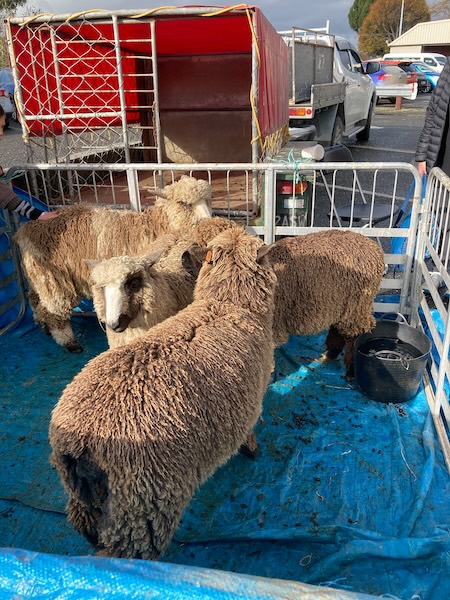
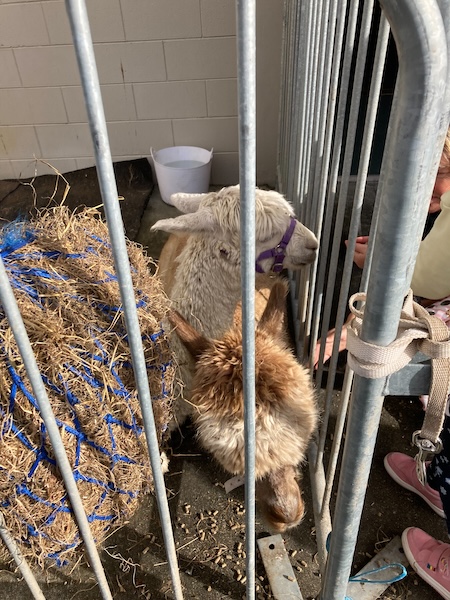
After all that, we were quite hungry, so we enjoyed some Thai chicken noodle soup and wontons for lunch from one of the food vendors, and it was so perfect and spicy and warm to eat outside on a cool autumn day.
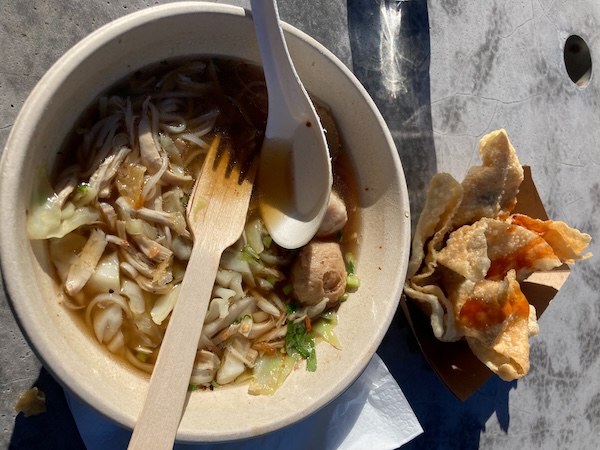
After lunch it was back into the venue, and we wandered around the traders some more. At this point we visited Purple Sprouting, where they had a wonderful selection of sock yarn. I fell in love with another sock yarn colourway, but had no money left to buy it. My wonderful friend then stepped in, and bought me a skein of 4 ply Bluefaced Leicester sock yarn in the colourway Meadow Mornings (Almost) as a thank you for me hosting her for the week. I was so excited about this, and the yarn is already on my knitting needles to knit a pair of socks.
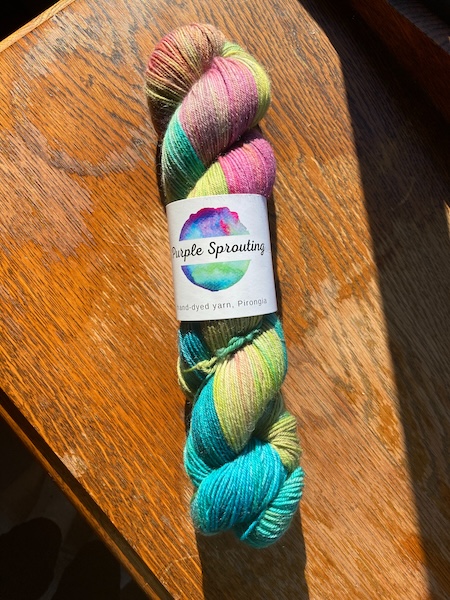
And just when I thought it was all over, we happened to walk past Spinning Wood Designs, who handcraft spinning drop spindles and fibre tools in South Canterbury. And it was there I found the wrist distaff I've been searching for in New Zealand for the past two years. And before you could blink an eyelid, I'd picked out a distaff and handed over my credit card, overjoyed that I'd finally found one. I knew hubby wouldn't mind that I overspent my crafty budget for this, as I have been talking about getting a wrist distaff for a long time.
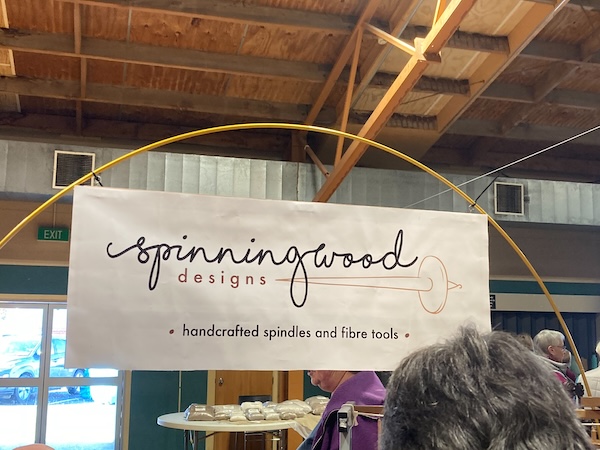

And with that done it was nearly time to go home. All that remained was staying for the raffle drawing, as I had used the $1 I had left in my purse to buy one raffle ticket for the spinning prize. And after telling my friend that I never, ever won raffle prizes, I won!
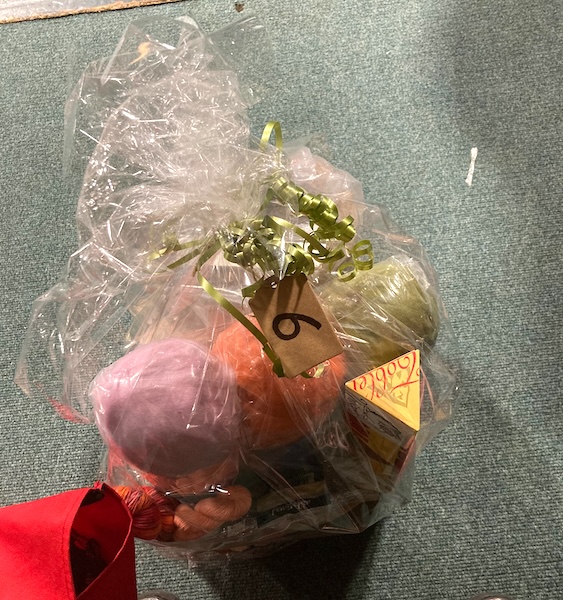
I was so happy and excited and grateful to win the raffle, as it was filled with lots of goodies I knew I would love to use. Once we got home, I unpacked the raffle prize, and shared my spoils with hubby and my friend.
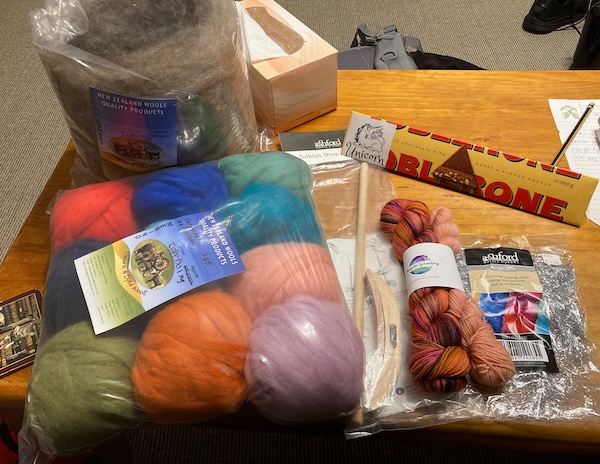
I gave hubby the giant Toblerone chocolate bar gifted from Unicorn Fibre Cleaners, and I gave my friend the Purple Sprouting sock yarn pack, and kept all the spinning goodies for myself (my friend isn't a spinner). My prizes included a 1 kg bump of naturally dyed romney from Tally Ho Carding, a 1 kg Carousel Collection of Merino also from Tally Ho Carding, a packet of Ashford Angelina silver sparkles to add to fibre projects, and an Ashford Turkish drop spindle.
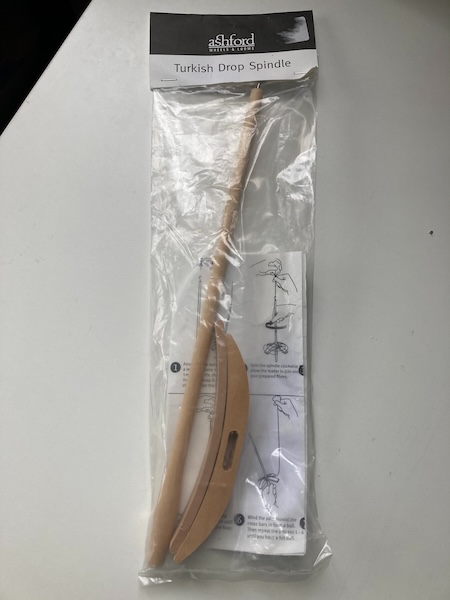

I was especially excited about the Turkish drop spindle prize, as it had been on my wish list of fibre tools for a long time. I can't wait to learn how to use it, and thanks to all the fibre I bought and that I won in the raffle, I will have plenty of fibre to practice on.
And with the wonderful fibre festival day at an end, my friend and I headed back home to recover, and play with all our new yarn and fibre goodies...
Have a wonderful day
Julie-Ann
Want to discuss my post? Feel free to chat with me on Instagram or Mastodon or Bluesky.
Spinning Ashford Avacado Merino/Silk Fibre
Hello friends,
Over the summer holidays I caught up with a few crafting projects that in the last few months have been left languishing on the to do pile because of the busy Christmas season for work. When I'm not gardening, crafting, reading, or writing this blog, I have my own online Felt store, Hearth & Oak, selling textile products that I make.
The first crafting project I got to do over the holidays, was to finish spinning 200 grams of Ashford Avacado merino/silk blend I've had for over a year. I love the colours that Ashford use in their colour ways, and their merino/silk blends are always very easy to spin.
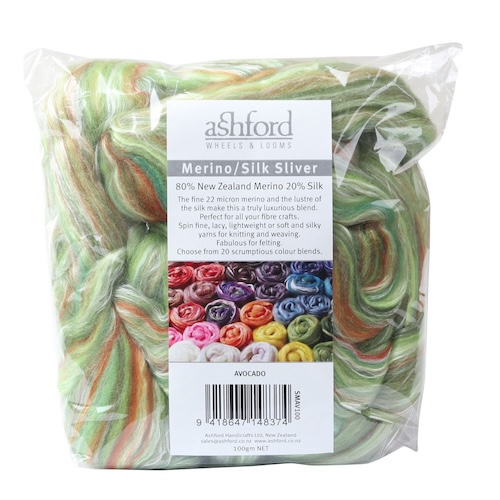
I learned to spin when I lived in Wellington, and was first taught to spin on a drop spindle by Frances Stachl at a workshop at Holland Road Yarn Company in Petone. I bought my rimu drop spindle off Frances at the workshop, and my drop spindle is my pride and joy, and I'm glad I got one of hers before she stopped woodworking. It is light and perfectly balanced, and spins like a dream.
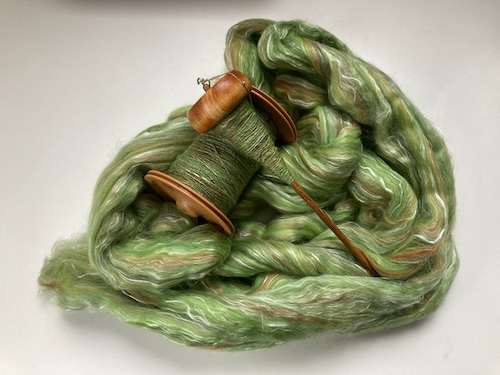
When I started this project last year, I had begun spinning it on my drop spindle, but when I started again in the holidays, I switched to my spinning wheel, which is a New Zealand made Majacraft Suzie Professional spinning wheel. I bought this wheel when I lived in Wellington, and I love the weighted wheel and double treadles, which makes it easy to spin for a long period of time without any issues. In general I just spin for the fun of it, and then decide what to make with the yarn later, and that's what I did this time. I know some people will have conniptions about this, but sometimes I just like to spin for the fun of it.
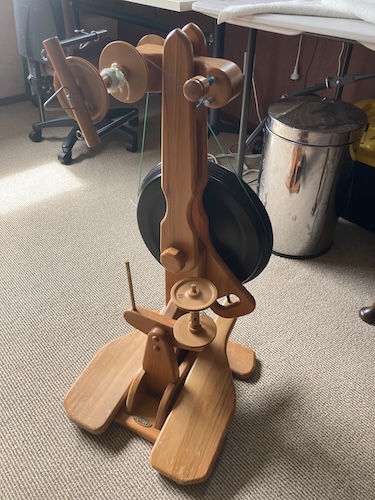
It didn't take long to spin up the 200 grams of fibre into two 100 grams singles.
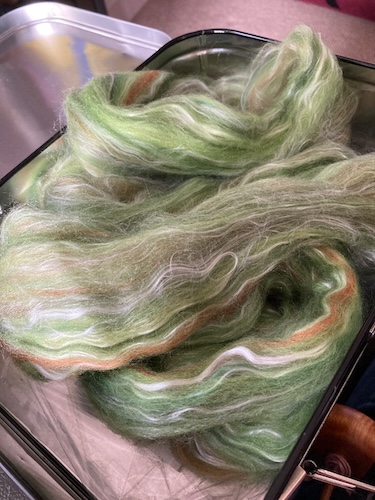
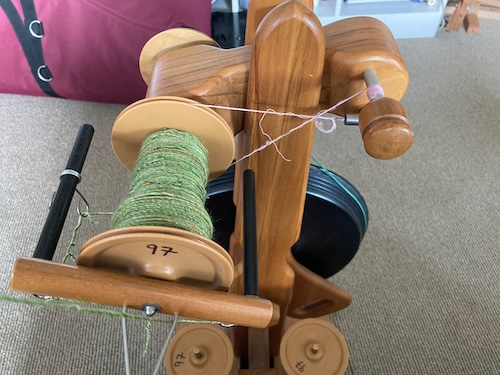
After letting the bobbins rest for a day, I set up my spinning wheel for plying, and it didn't take long at all to ply the yarn in the "Z" twist direction.

And after letting the plied yarn rest on the bobbin for a couple of days, I wound it into a skein, and then washed it to set the twist. And now my Ashford Avacado merino silk yarn is now ready to be turned into something new, my plan at the moment is to weave it into a scarf, but that will happen later on in the year.
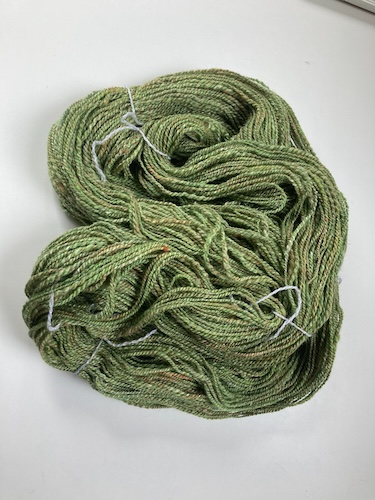
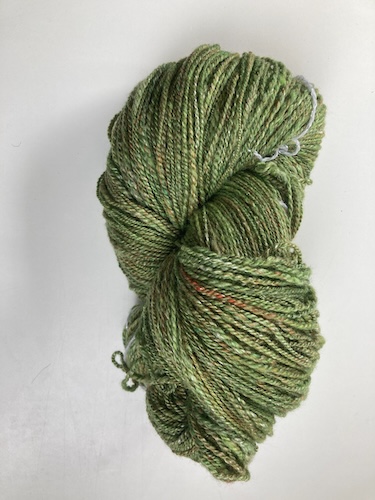
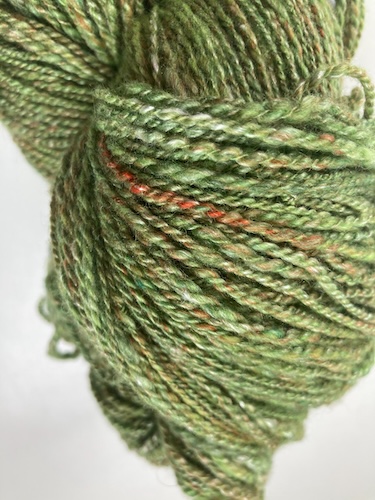
Did you get up to much over the Christmas break? I love to use that time to do stuff I've been wanting to do for a while.
Have a wonderful day.
Julie-Ann
Want to discuss my post? Feel free to chat with me on Instagram or Mastodon.
Acid Dyeing Yarn For My Gro Hat Knitting Project
Hello friends,
I was on Instagram about a month ago, and saw a knitted hat on my feed that I immediately fell in love with. The hat was a project based on the Gro Pattern by Fiber Tales. I loved the cabled plant motif, and how nice and toasty it looked like in the pattern photos, so I bought a copy of the pattern.
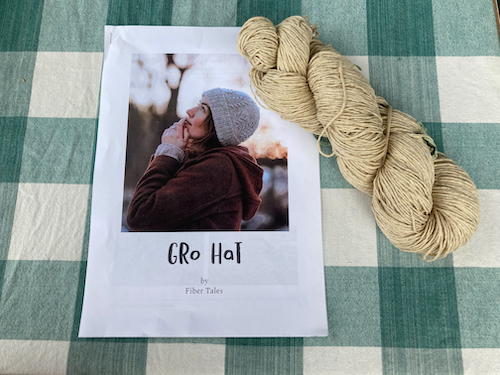
The pattern calls for one 100 gram skein of DK (double knit) yarn, and I knew I had a lot of undyed superwash DK possum/merino yarn (that I got from one of the Woolyarn outlet store sales when I lived in Wellington) in my stash.
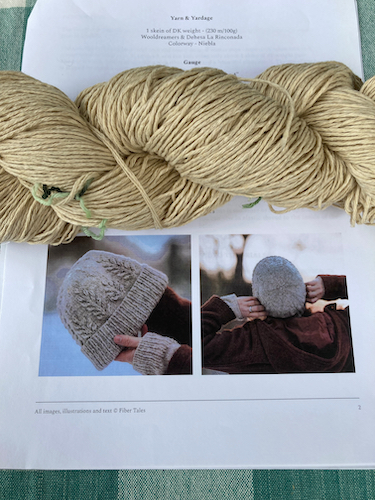
I also knew what colour I wanted to dye the yarn. Back when I was living in Wellington I processed, dyed, spun, and knitted, a huge shawl for a Creative Fibre exhibition called the Southern Skies shawl using raw alpaca fleece a friend on a farm gave me. I had processed and dyed white alpaca fleece in sequential aurora colours based on a photo I had taken of an aurora, spun up each section of yarn, and then knitted the project, adding silver beads to show the constellations of the southern night sky.
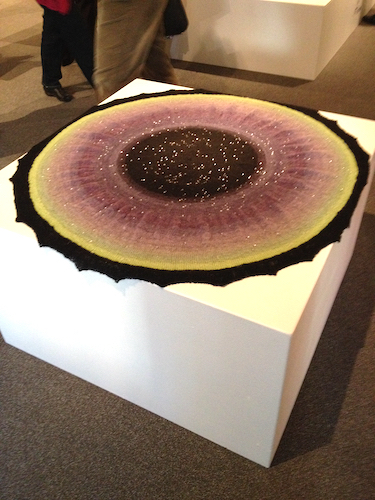
One of the colours in the shawl was a beautiful sage green, called Aurora 4 according to my dyeing notes, and this was the colour I wanted to dye for this hat project.
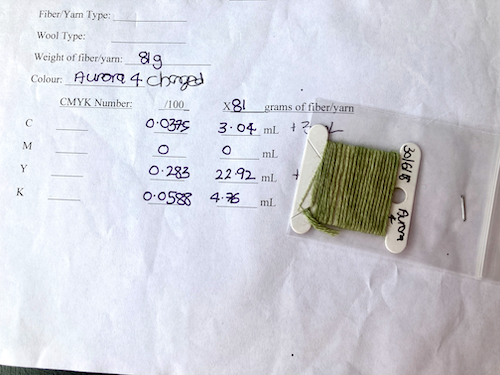
After checking my dyeing project notes I calculated how much dye I would need to add to this project. The total amount of yarn I chose for this project was 123 grams of undyed superwash yarn. I used more yarn than the pattern suggested, because it is good to have extra for swatching, and also to not have to play yarn chicken.
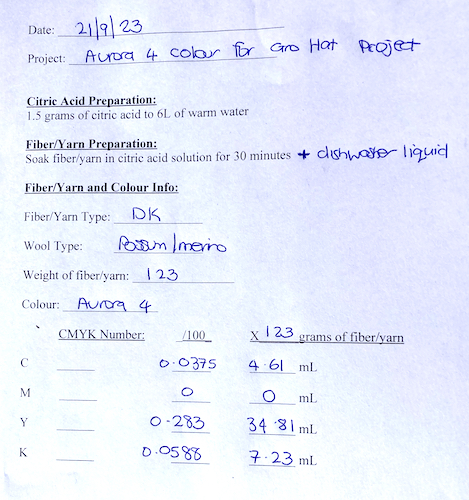
I've included in here my calculations for getting the aurora 4 colourway. When it comes to dyeing yarn, I used Ashford dyes, and mainly in the colours Teal, Hot Pink, Yellow, and Black, which are equal to Cyan, Magenta, Yellow, and Black. Combing these 4 colours can lead to an infinite number of colours. My Ashford dyes are made up as a 1% depth of shade (DOS) stock solution. For this project, I know the relative proportions of teal, yellow, and black I need to make the aurora 4 shade. I need to add 4.61 mL, 34.81 mL, and 7.23 mL of each respective dye stock solutions to dye 123 grams of possum merino yarn.
The first step in acid dyeing yarn is to make up the acid solution for dyeing. Ashford suggests to add white vinegar to make the water acidic, but it is horrible to work with when heated, and the fumes make my eyes water. So instead I have developed a system to use citric acid, which is easier to work with. To make up the citric acid water you add 1.5 grams of citric acid (which you can get from any supermarket) to 6L of water, and mix well. This is the solution you soak your yarn in, make up the DOS solutions, and also to dye in. To check the pH is at 4, I used a pH strip that I picked up from Trade Me.
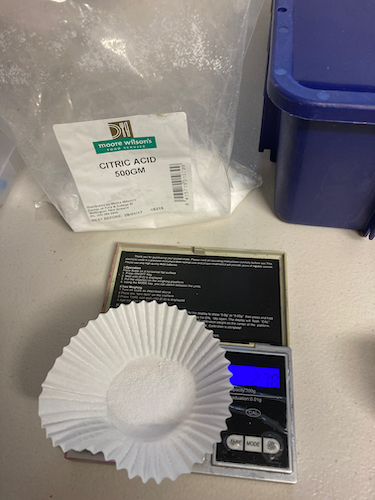
The next step in dyeing is to pre-soak the yarn. Into a container add some of the citric acid water and also a splash of unscented Ecostore Dishwashing Liquid, followed by the yarn you want to dye. The dish washing soap is in there to help open up the fibers so that the whole skein of yarn is wet through and ready for dyeing. I usually leave this to soak for 30 minutes.
When it came to getting out the acid dye stock solutions, I had previously run out of yellow stock solution, so I had to make up a new batch. To 198 grams of citric acid water I added 2 grams of Ashford yellow dye. I measure this out into a paper muffin cup on a small scale that I picked up on trade me. With this step is important to wear gloves and a mask (I used a N95 mask), not only to not dye my hands, but also to protect my lungs from the fine dye mist.
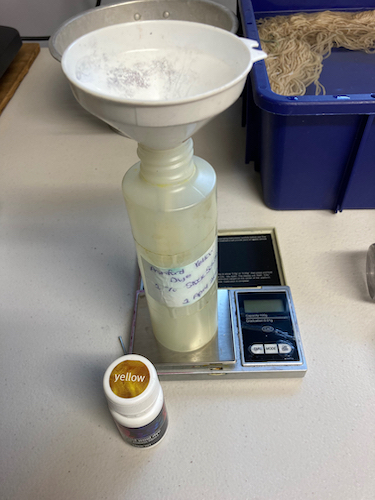
Once the yellow dye was well mixed, it was time to measure out the teal, yellow, and black stock solutions. After mixing each container well, I measured out each of the colours calculated above using plastic pipettes (which I also got from Trade Me) and the small scale and combined them. The aurora 4 colour was added to 6L of citric acid which was heating up in a stainless steel pot on the stove top, and mixed well. The yarn sitting in the solution was then wrung out and then added to the heating pot.
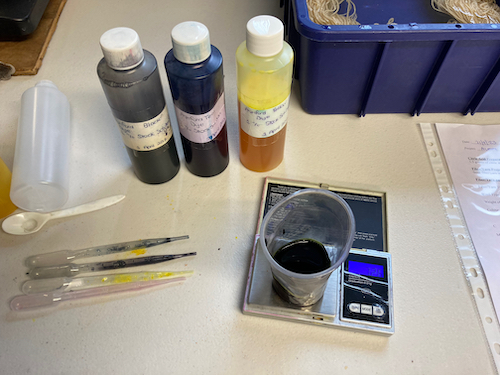
The yarn began to take up the dye straight away, and was gently mixed occasionally as the pot heated up to a simmer. The yarn and the pot was then left to simmer for 15 minutes. At the end of this time, the yarn had completely taken up the dye, and the citric acid water was clear when finished. The pot was turned off and left to cool.
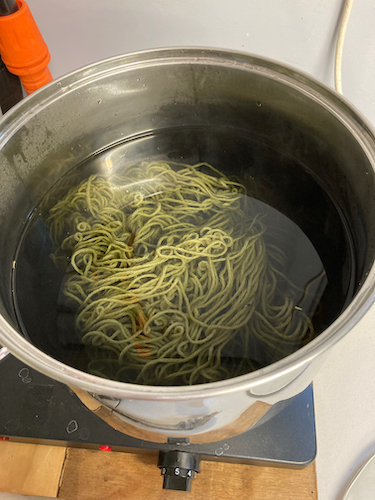
When the water had cooled, the yarn was removed from the pot. The citric acid water was left to cool to room temperature, and then baking soda was added to the water to return it to a pH of 7 (using a pH test strip), then discarded down the drain. The yarn was rinsed twice in luke warm water which had a little dish washer liquid added to it, not only to rinse out the citric acid water, but also to check that all the dye had indeed stuck permanently to the yarn. The yarn was then spun dry using the washing machine, and then left to dry outside.
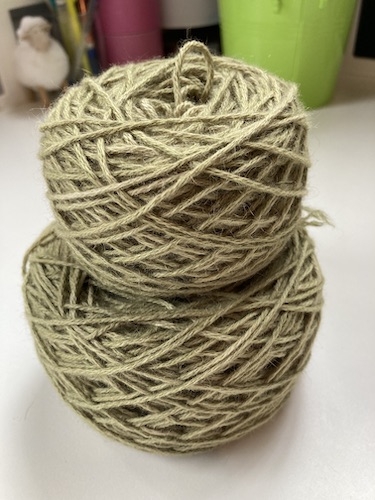
This is the finished yarn, and I'm really happy with it. I think because of the original colouring of the undyed yarn before dyeing, it's not quite the same as the sample yarn of the aurora 4 colour I have on file, but it's still close enough that I'm happy to start knitting with it.
Hopefully I'll have the hat knitted up over the coming spring and summer, so that it'll be ready to wear next autumn.
Have a wonderful day
Julie-Ann
Want to discuss my post? Feel free to chat with me on Instagram or Mastodon.




